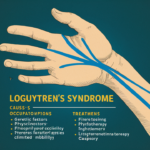In the realm of digital health and wellness, few conditions have garnered as much attention and concern as loguytren problems. These issues, primarily affecting the musculoskeletal system, represent a growing concern for millions worldwide. Loguytren problems encompass a spectrum of disorders characterized by abnormal tissue growth in the palms, leading to finger contractures and significant functional limitations. This condition, first described in medical literature centuries ago, continues to challenge both healthcare professionals and patients alike, demanding a deeper understanding of its complexities.
The Anatomy and Development of Loguytren Problems
Loguytren problems originate from the intricate network of tissues within the palm, specifically affecting the palmar fascia—a dense connective tissue layer beneath the skin. This fascia normally functions as a supportive structure, maintaining the integrity and flexibility of hand movements. However, in individuals developing loguytren problems, abnormal nodules begin forming within this tissue, typically starting at the base of the fingers along the creases of the palm. These nodules, composed of fibrous tissue, gradually evolve into thickened cords that pull the fingers toward the palm, creating characteristic contractures.
The progression of loguytren problems follows a distinct pattern, beginning with subtle changes that many initially dismiss as minor discomfort or stiffness. In the early stages, small lumps or pits may appear on the palm, often accompanied by slight tenderness. As the condition advances, these nodules transform into palpable cords that extend from the palm to the fingers. The ring and little fingers are most commonly affected, though any digit can become involved. The cords progressively tighten, causing the fingers to curl inward, making it increasingly difficult to fully extend them. This process can span months to years, with varying degrees of severity among affected individuals.
Several key factors influence the development and progression of loguytren problems. Genetic predisposition plays a significant role, with research indicating that up to 65% of cases demonstrate familial patterns. Ethnic background also appears to be a determining factor, as Northern European populations show higher incidence rates compared to other ethnic groups. Age is another critical variable, with the condition rarely appearing before age 40 and becoming increasingly prevalent in older adults. Hormonal influences, particularly testosterone levels, seem to contribute to the male predominance observed in clinical studies, where men are affected three to four times more frequently than women.
| Factor | Description |
| Genetic Predisposition | Up to 65% of cases have family patterns. |
| Age | Rarely appears before age 40. |
| Ethnicity | Higher incidence in Northern European populations. |
| Hormonal Influence | Testosterone levels contribute to male predominance. |
The Multifaceted Impact of Loguytren Problems on Daily Life
The consequences of loguytren problems extend far beyond the physical manifestations visible in the hand. These conditions significantly alter daily living, affecting both personal and professional spheres in profound ways. For many individuals, simple tasks that once required minimal thought become challenging obstacles requiring careful planning and adaptation. Basic hygiene routines, such as washing one’s face or brushing teeth, become labor-intensive exercises when fingers cannot fully extend. Dressing oneself presents similar difficulties, particularly with buttons, zippers, and shoelaces, often necessitating alternative clothing choices or assistance from others.

In the workplace, loguytren problems can severely impact productivity and career advancement. Manual dexterity suffers substantially, affecting everything from typing speed to operating machinery. Professionals in fields requiring precise hand movements—such as surgeons, musicians, or artisans—may find their careers threatened by the progressive nature of the condition. Even office workers face challenges with computer use, writing, and handling documents. The psychological toll of reduced work performance often leads to decreased confidence and anxiety about job security, creating a cycle of stress that can potentially worsen the condition itself.
Social interactions and personal relationships frequently bear the brunt of loguytren problems’ impact. Handshakes, once automatic gestures of greeting, become sources of embarrassment or avoidance. Participating in social activities, from dining out to recreational sports, requires conscious modification of behavior. Many individuals report feeling self-conscious about their hand appearance, leading to social withdrawal and isolation. The inability to participate fully in family activities, from playing with children to helping with household chores, can strain relationships and create emotional distance between loved ones.
Identifying and Diagnosing Loguytren Problems: Early Signs and Clinical Assessment
Recognizing the early warning signs of loguytren problems represents a critical step in effective management and treatment. Initial symptoms often manifest subtly, making vigilance essential for timely intervention. The first noticeable change typically appears as persistent discomfort or thickness in the palm, particularly along the crease lines. Patients may observe small indentations or dimples in the skin surface, often accompanied by tender nodules that feel firm to the touch. These early indicators might be mistaken for calluses or simple irritation, but their persistence and specific location warrant closer examination.
As loguytren problems progress, distinctive physical characteristics become more apparent. Thickened cords begin forming beneath the skin, running from the palm toward the fingers. These cords may initially feel like tight bands just below the skin’s surface. Affected individuals often notice difficulty laying their hand flat on a surface or spreading their fingers wide apart. The classic “table-top test” serves as a simple diagnostic tool: inability to place the entire palm flat against a table suggests potential loguytren involvement.
Treatment Options for Loguytren Problems: From Conservative Measures to Advanced Interventions
Addressing loguytren problems requires a nuanced approach that considers both the severity of symptoms and individual patient needs. Conservative treatments form the foundation of initial management strategies, focusing on non-invasive methods to alleviate discomfort and maintain hand function. Physical therapy emerges as a primary conservative option, incorporating specialized stretching exercises designed to preserve finger mobility and prevent contracture progression. Therapists often recommend night splinting, using custom-fitted devices that maintain proper finger alignment during sleep.
Medications play a supporting role in managing loguytren problems, though their effectiveness varies among patients. Nonsteroidal anti-inflammatory drugs (NSAIDs) can help reduce inflammation and manage discomfort during flare-ups. More recently, injectable therapies have gained attention, particularly collagenase clostridium histolyticum (CCH), which enzymatically breaks down collagen in the fibrous cords. This FDA-approved treatment involves precisely administered injections followed by manipulation of the affected finger, offering a less invasive alternative to surgery.
When conservative measures prove insufficient, surgical intervention becomes necessary. Fasciotomy procedures involve cutting through the contracted cords to release tension, restoring finger movement. This approach ranges from limited open surgery to percutaneous needle fasciotomy, where specialized needles break apart the fibrous tissue through small punctures. For more advanced cases, partial palmar fasciectomy removes the diseased tissue entirely, offering more definitive results at the cost of more extensive recovery and potential complications.
Prevention Strategies and Lifestyle Modifications for Managing Loguytren Problems
While complete prevention of loguytren problems remains challenging due to their strong genetic component, strategic lifestyle modifications can significantly influence disease progression and symptom severity. Occupational adjustments stand paramount among preventive measures, particularly for individuals in professions requiring repetitive hand movements or sustained gripping. Implementing ergonomic workstations, utilizing power tools instead of manual alternatives, and scheduling regular hand rest periods can markedly reduce mechanical stress on vulnerable tissues.
Dietary considerations play a crucial role in managing systemic factors that may influence loguytren problem progression. Anti-inflammatory diets rich in omega-3 fatty acids, found in foods like salmon, walnuts, and flaxseeds, help combat chronic inflammation underlying fibrous tissue formation. Increasing consumption of fruits and vegetables high in antioxidants, particularly vitamin C and E, supports collagen metabolism and reduces oxidative stress.
Navigating the Psychological and Emotional Challenges of Loguytren Problems
Living with loguytren problems extends beyond physical limitations, creating profound psychological and emotional challenges that demand equal attention. The visible nature of hand deformities often triggers deep-seated self-consciousness, leading to social anxiety and withdrawal behaviors. Individuals frequently report feelings of embarrassment during social interactions, avoiding situations where handshakes or manual tasks might draw attention. This social apprehension can escalate into full-blown social phobia, particularly when combined with concerns about professional competence and public perception.

Support networks play a crucial role in mitigating these psychological challenges. Peer support groups, both in-person and online, offer invaluable opportunities for shared experiences and practical coping strategies. Professional counseling, particularly cognitive-behavioral therapy (CBT), proves exceptionally effective in addressing distorted thoughts about self-worth and capability.
Future Perspectives and Advancements in Loguytren Problem Management
The landscape of loguytren problem management stands on the cusp of transformative change, driven by rapid advancements in biotechnology and personalized medicine. Emerging research into genetic markers promises revolutionary breakthroughs in predictive diagnostics, enabling identification of at-risk individuals decades before symptom onset. Scientists are currently mapping specific gene mutations responsible for fibroblast proliferation, paving the way for targeted gene therapies that could potentially halt disease progression at its source.
Biomedical engineering innovations are reshaping surgical approaches to loguytren problems through the development of smart implants and regenerative scaffolds. These bioengineered materials mimic natural tissue architecture while releasing therapeutic agents directly to affected areas, promoting healing and preventing recurrence. Nanotechnology applications are enhancing drug delivery systems, allowing for sustained release of medications at microscopic levels within fibrous cords.
FAQs
What are the early signs of loguytren problems?
Early signs include persistent discomfort or thickness in the palm, small indentations in the skin, and tender nodules.
How is loguytren’s contracture diagnosed?
Diagnosis involves a physical examination, the “table-top test,” and may include imaging techniques like ultrasound.
What treatment options are available for loguytren problems?
Treatment options range from physical therapy and medications to surgical interventions such as fasciotomy.
Can lifestyle changes help manage loguytren problems?
Yes, ergonomic adjustments, dietary changes, and regular exercise can significantly influence the progression of the condition.
Is there a cure for loguytren problems?
Currently, there is no cure, but various management strategies can help control symptoms and maintain hand function.
Embracing a Proactive Approach to Loguytren Problem Management
The journey through understanding and managing loguytren problems reveals a complex interplay of biological, environmental, and lifestyle factors demanding comprehensive attention. This condition, characterized by progressive fibrous tissue formation in the palm, extends its influence far beyond mere physical limitations, impacting every facet of daily living from personal hygiene to professional capabilities.
Key takeaways from this comprehensive exploration emphasize the importance of early recognition and proactive management. The subtle initial symptoms, often dismissed as minor discomfort, can rapidly progress if left unaddressed. Regular self-assessment, coupled with professional monitoring, enables timely intervention that can significantly alter disease progression.
fore more detalies visit grammargurus

I m John Nicker a Content Writer and SEO Expert with 5 years Experiness. I have Already work on BBC News Website.
















